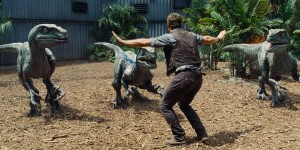
One of the adages in Hollywood begins with “What I really want to do…” Few actually get to transition to new occupations in an industry which relishes pigeonholing its artists and craftspeople. Case in point, coming from the world of production illustration, Ed Verreaux eventually told director Steven Spielberg that he would like to one day become a full-fledged production designer. Spielberg, who had used Verreaux’s illustration talents on Raiders of the Lost Ark and its early sequels, E.T. The Extra Terrestrial and Empire of the Sun, among many others, effectively challenged Verreaux to go after his goal. This ultimately led to Verreaux becoming an assistant art director on the Back to the Future sequels, culminating in his ascent to art director on the first Jurassic Park. “I was an art director on the first one, and Steven pulled me off to illustrate Hook,” Verreaux explained. “Then I moved off to do Honey I Blew Up the Kid as art director.”
Nearly a decade later, Verreaux would finally get the chance as full production designer on a Jurassic Park film with Jurassic Park III. By that point, however, he already been the production designer on Contact and Mission to Mars. Many films would follow in the 2000s including work on X-Men: The Last Stand and G.I. Joe: The Rise of the Cobra before word of another Jurassic Park film arose. “I got a call from Rick Carter who is Steven’s go-to guy,” Verreaux recalled of the start-up of Jurassic World. “He did some pre-[production] work with a small group of designers. Then, Star Wars came up for him. I was in New Orleans doing a TV pilot, so Rick called me: ‘Can you come out for a day to L.A. and meet Colin Trevorrow [Jurassic World’s director]?’ He wanted me to do it. I finished up my New Orleans obligations and came back.”
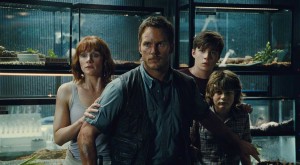 With Carter off for good to design Star Wars – Episode VII, Verreaux was on board as Jurassic World’s production designer. Then the large-scale project hit an early snag. “We did eight weeks of prep and scouted locations in Hawaii, and Steven indefinitely shut it down,” explained Verreaux, who had been meeting with Phil Noyce about his film The Giver. Verreaux then went to South Africa for eight months of production design duties on The Giver, during which Jurassic World finally got back on track and required immediate design attention. “Pat Crowley, the line producer, needed me to come back right away. We were able to get Doug Meerdink to pinch hit for me as supervising art director. He was mocking sets up in Maya, getting notes and talking to Colin.”
With Carter off for good to design Star Wars – Episode VII, Verreaux was on board as Jurassic World’s production designer. Then the large-scale project hit an early snag. “We did eight weeks of prep and scouted locations in Hawaii, and Steven indefinitely shut it down,” explained Verreaux, who had been meeting with Phil Noyce about his film The Giver. Verreaux then went to South Africa for eight months of production design duties on The Giver, during which Jurassic World finally got back on track and required immediate design attention. “Pat Crowley, the line producer, needed me to come back right away. We were able to get Doug Meerdink to pinch hit for me as supervising art director. He was mocking sets up in Maya, getting notes and talking to Colin.”
After his responsibilities on The Giver wrapped, Verreaux returned to begin full-time work on Jurassic World. “When I got back to L.A., we hit the ground running,” he said of the film’s numerous design challenges, often an expansion of the establishing ideas from the original films. “We designed everything in advance with comprehensive production illustrations,” Verreaux said in a nod to his former specialty. “Even the stuff that didn’t get built on set, we did the designs so that the CG vendors could build the objects.”
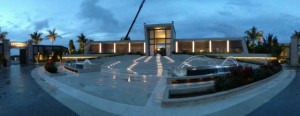 In one crucial design hurdle, the Samsung Innovation Center is a modified updated visitor center as seen in the first film. The new one has a multilevel structure with interactive digital displays and holograms: “A reflection of the visitor center from the first movie,” Verreaux noted.
In one crucial design hurdle, the Samsung Innovation Center is a modified updated visitor center as seen in the first film. The new one has a multilevel structure with interactive digital displays and holograms: “A reflection of the visitor center from the first movie,” Verreaux noted.
Offsetting that edifice is a sizable pedestrian thoroughfare lined with shops and restaurants that Verreaux designed and built outside of New Orleans, La. “We put a tremendous amount of detail into these sets,” Verreaux related. “We laid it out, projected it in 3D software and built a model. That’s what we would use when we had our production meetings. It was carefully plotted with a lot of Jurassic-inspired design; all of the doors were carved. You only see 50%, but you build to 80%. We focused on detail as well as broad strokes, creating the setting for the story to take place. We build a world and populate it with details.”
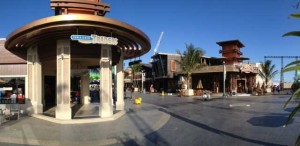 Indeed, the “main street” set, built in the parking lot of a derelict amusement park which was destroyed by Hurricane Katrina, was a staggering 150 yards long, located in the same spot where the gargantuan “Ape City” set was built for Dawn of the Planet of the Apes. “If you had walked through our set, you would have seen a tremendous amount of detail,” Verreaux stated. “It was a long ongoing process working with vendors to get their logos so that it really looked like a real theme park sponsored by Samsung, Starbucks and Sharper Image. We did that on purpose. Generating product placement funds doesn’t behoove us at the front end. It goes to distribution and visual effects at the back end. It was important to include all of that as part of the look of the movie.”
Indeed, the “main street” set, built in the parking lot of a derelict amusement park which was destroyed by Hurricane Katrina, was a staggering 150 yards long, located in the same spot where the gargantuan “Ape City” set was built for Dawn of the Planet of the Apes. “If you had walked through our set, you would have seen a tremendous amount of detail,” Verreaux stated. “It was a long ongoing process working with vendors to get their logos so that it really looked like a real theme park sponsored by Samsung, Starbucks and Sharper Image. We did that on purpose. Generating product placement funds doesn’t behoove us at the front end. It goes to distribution and visual effects at the back end. It was important to include all of that as part of the look of the movie.”
Another triumphant exterior set houses the underwater Mosasaurus, a gigantic sea-based dinosaur, in what looks like a killer whale tank at Sea World – times ten. “We did two sets of bleachers and built the indoor sets at the old NASA facility – large hangars for building parts of the space shuttle,” Verreaux explained. “We had people in the bleachers, and we’d hit them with big dump cannons. Everything else was set extensions.”
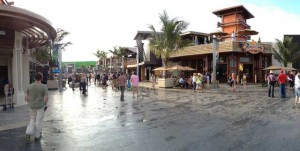 Another exterior set contains a velociraptor training area which Verreaux actually designed in South Africa during his extended tenure on The Giver. “Crowley sent me the script, so I came up with that idea, then sent thumbnails to my art director to develop them in 3D,” Verreaux commented. “Vincent D’Onofrio was a military industrial guy who has taken over the military applications of the dinosaurs. The idea was to give it a military look – a portable military field picked up by helicopter. It was built in Louisiana, outdoors, across from the NASA facility. Next to that was swampy forest. We built it right there. We enhanced it all with green. We brought in 50 palm trees. The other direction was the parking lot.”
Another exterior set contains a velociraptor training area which Verreaux actually designed in South Africa during his extended tenure on The Giver. “Crowley sent me the script, so I came up with that idea, then sent thumbnails to my art director to develop them in 3D,” Verreaux commented. “Vincent D’Onofrio was a military industrial guy who has taken over the military applications of the dinosaurs. The idea was to give it a military look – a portable military field picked up by helicopter. It was built in Louisiana, outdoors, across from the NASA facility. Next to that was swampy forest. We built it right there. We enhanced it all with green. We brought in 50 palm trees. The other direction was the parking lot.”
In Jurassic World’s most mysterious sequence, park workers enter the jungle-laden compound of a genetically-engineered dinosaur nicknamed the “I-Rex.” “We filmed the I-Rex compound on Oahu in Hawaii,” Verreaux explained. “It was a question of color of the foliage, and the way it looks. We had so much jungle work, from a visual standpoint, we needed to do it in Hawaii. We worked the budget around. We built it as an indoor-outdoor set. We built two walls of it. Halfway up was the observation space; the other wall was the door. In the inner paddock area, we built a lot of trees to fill it in. You couldn’t see the I-Rex. She could camouflage herself.”
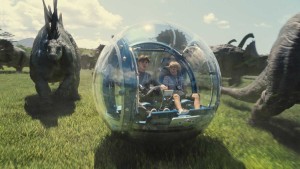 Similar to the daytime exteriors in the initial Jurassic Park, the crew of Jurassic World filmed a great deal of day-for-day outdoor material on the Hawaiian Islands. “The stuff that we did in Hawaii had good production value,” Verreaux described. “including the valley in Oahu for the helicopter landing pad. For the scene with his crew of containment guys, we used the old WWII gun bunker. We went over to Kauai where the boys go through the broken fence, the waterfall, and the chase where the children are in the gyrosphere with the I-Rex chasing them.”
Similar to the daytime exteriors in the initial Jurassic Park, the crew of Jurassic World filmed a great deal of day-for-day outdoor material on the Hawaiian Islands. “The stuff that we did in Hawaii had good production value,” Verreaux described. “including the valley in Oahu for the helicopter landing pad. For the scene with his crew of containment guys, we used the old WWII gun bunker. We went over to Kauai where the boys go through the broken fence, the waterfall, and the chase where the children are in the gyrosphere with the I-Rex chasing them.”
One wholly new element in Jurassic World is the aforementioned self-contained gyrosphere which serves as a vehicle in which the two main boys traverse a dinosaur paddock. “The gyrosphere was an early idea of Steven’s, to make it possible to get out among the animals,” said Verreaux. “We went through a lot of little design tweaks to get it just right. The overall design was all finished by the time we shut the show down the first time. They had started to begin to build it.”
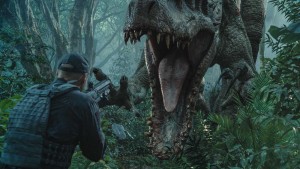 For ardent fans of the original film, the filmmakers included a sequence where the two boys, having escaped the I-Rex, find the remains of the original Jurassic Park facilities. “We did the park from the first film in a valley behind Honolulu,” Verreaux said. “We filmed part of Jurassic III up there. It was an old zoological bird park called Paradise Park. We built it to be site specific – first level only. Everything above that fell off into the darkness or was digitally extended.”
For ardent fans of the original film, the filmmakers included a sequence where the two boys, having escaped the I-Rex, find the remains of the original Jurassic Park facilities. “We did the park from the first film in a valley behind Honolulu,” Verreaux said. “We filmed part of Jurassic III up there. It was an old zoological bird park called Paradise Park. We built it to be site specific – first level only. Everything above that fell off into the darkness or was digitally extended.”
With two Jurassic Park films now under his belt, Verreaux is satisfied with the results of the two singular films. “The other one required different types of logistics,” he said. “The size of this film was really fun. We got to build a full amusement park. As a production designer, you want to make it fit the story. It is fun to build big stuff. It was very gratifying at first being with Colin down in New Orleans with some stakes in the ground. After Hawaii, he walked down Main Street and was amazed. ‘That was fantastic!’ You usually don’t get that from directors. He was very moved.”





